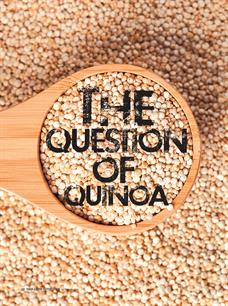This formerly obscure Andean cereal-like crop, that proliferates on the Bolivian Plateau, is feted for its health properties. Quinoa (pronounced ‘keen-wa’) is actually a chenopod, related to species like beets and spinach. Its seeds have a light, nutty taste and, when cooked, become almost translucent. An unusually high protein content (about 16 per cent) for a ‘grain’ makes it a credibly nutritious meat substitute. Add to that its cache of amino acids and you have a wholesome crop that health-conscious pundits want.
.png)
In the USA alone, imports more than doubled from 2006 to 2008, then doubled again to 22,3 million pounds (about 10 million kilograms) from 2008 to 2010. Consequently, the price has tripled since 2006, with the United Nations even declaring 2013 as the International Year of Quinoa: “Faced with the challenge of increasing the production of quality food to feed the world’s population in the context of climate change,” reads their statement, “quinoa offers an alternative for those countries suffering from food insecurity.” And yet, ironically, quinoa is no longer affordable to the very people it is supposed to be feeding – the Andean folk. “Poor Bolivians can no longer afford their staple grain,” handwrings the press. And, meanwhile, the rapacious demand for quinoa continues to gain momentum.
According to Bolivia’s agricultural ministry, the country’s consumption of its own staple has fallen 34 per cent despite, or perhaps because of, the increase in global demand. Quinoa is now a luxury product with the price to match. In Lima, Peru, it costs more than chicken, The Guardian reports. Since fewer urban Bolivians can afford it, it has hastened their embrace of cheaper, processed foods, raising fears of malnutrition. But is the worldwide demand for this superfood really causing undue harm? “We’ve all read the stories about how poorer Bolivians and Peruvians, who may have counted on quinoa for inexpensive sustenance, can no longer afford this very nourishing food,” counters Cynthia Harriman, director of Food and Nutrition Strategies for the Whole Grains Council. “But keep in mind that, while some people in that region may have a lower quality of life because of quinoa’s worldwide popularity, many of the farmers who grow it have seen a corresponding increase in their quality of life. They can now afford to send their kids to school and get beyond hand-to-mouth living.” Based in Boston, USA, it’s the mandate of the Whole Grains Council to promote wholegrain foods and help consumers understand its health benefits.
“The best solution for the Andean poor is to ensure enough quinoa is grown in other countries,” says Harriman. “Perhaps then it will be affordable for the urban poor in Bolivia and Peru, but still provide a reasonable living for the subsistence quinoa farmers.” That’s exactly what’s been happening in north America where farmers have been experimenting – with estimable success – with quinoa varieties for the last 20 years. Here, at the bottom tip of Africa, we are at the nascent stage of trying to replicate that success, says William Weeks, chairperson of NuGrainSA – a consortium involved in establishing quinoa, among others, as an alternative crop in SA.
.png)
“Currently, all our grains come from plants in the grass family, which is like having all your eggs in one basket,” asserts Weeks. “If a serious disease affecting grasses propagates, or there’s a rapid shift in global climate, we could be delivered into a famine situation. So, what needs to happen to alleviate the plight of the poor Bolivians is not a downscaling in demand, but rather an increase in production of quinoa in non-native countries.”
There is some catch-up to be played. “A lot of work lies ahead of us in SA as far as quinoa development is concerned. We are probably 20 years behind the rest of the world.” But conditions are promising: “Part of the promise held by the crop for Africa, lies in its adaptability and tremendous genetic variability,” surmises Weeks. This is not to say there hasn’t been experimentation already in Africa, where food-insecurity issues are often brought into sharp relief due to drought or political instability. In Kenya and Mali, the crop is already showing high yields, reports the Director-General of the Food and Agriculture Organization (FAO) of the UN, José Graziano da Silva. The first quinoa trials in SA will kick off this year. “Many questions must still be answered and numerous varieties must be tested, but the first steps have been taken,” says Weeks. Back to the Andes where, for farmers who participate in ANAPQUI (Asociación Nacional de Productores de Quinua) – the largest quinoa cooperative in Bolivia – increased demand has changed their lives for the better. “Before 1983 we did not have this operation [ANAPQUI] and we had to sell our quinoa at a very low price to the local market,” claims Daria Nina Apala, the wife of a quinoa farmer. So while the children of quinoa farmers benefit from the new-found profits of producing this golden grain, is the trade-off fair? Where do you stand on the quinoa conundrum?
.png)

